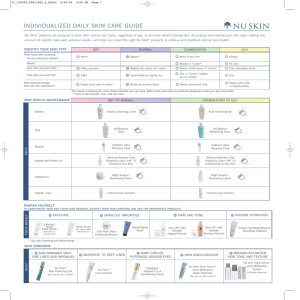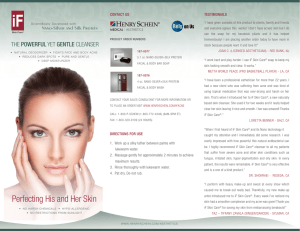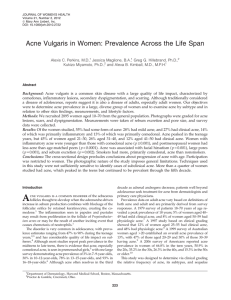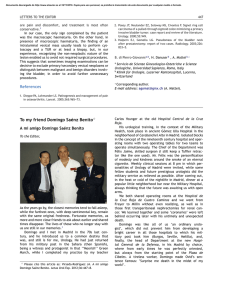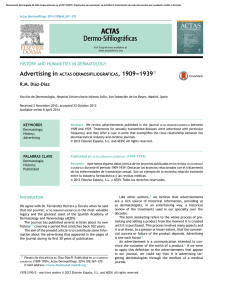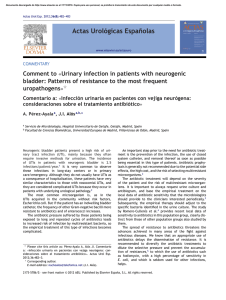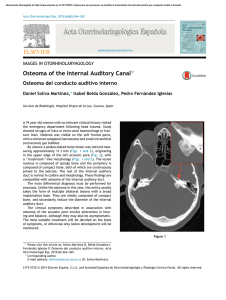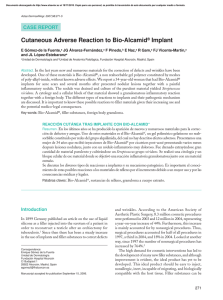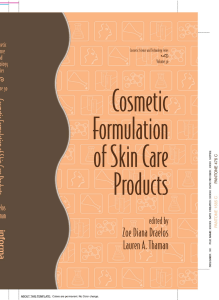Management of Acne in Women Over 25 Years of Age
Anuncio
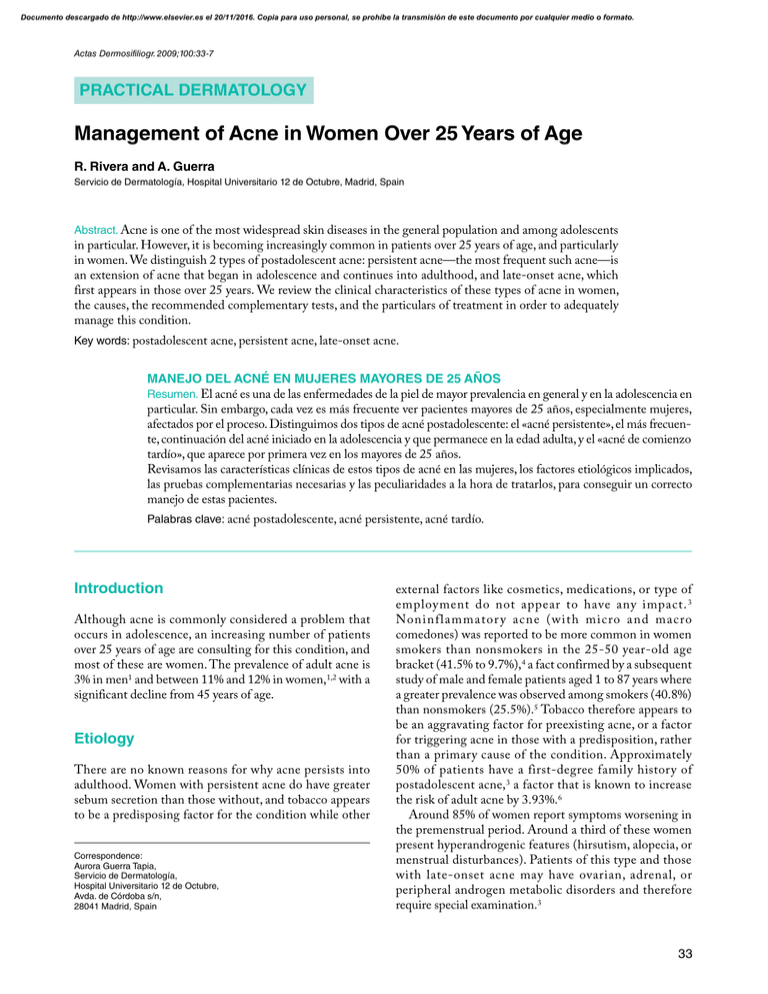
Documento descargado de http://www.elsevier.es el 20/11/2016. Copia para uso personal, se prohíbe la transmisión de este documento por cualquier medio o formato. Actas Dermosifiliogr. 2009;100:33-7 PRACTICAL DERMATOLOGY Management of Acne in Women Over 25 Years of Age R. Rivera and A. Guerra Servicio de Dermatología, Hospital Universitario 12 de Octubre, Madrid, Spain Abstract. Acne is one of the most widespread skin diseases in the general population and among adolescents in particular. However, it is becoming increasingly common in patients over 25 years of age, and particularly in women. We distinguish 2 types of postadolescent acne: persistent acne—the most frequent such acne—is an extension of acne that began in adolescence and continues into adulthood, and late-onset acne, which first appears in those over 25 years. We review the clinical characteristics of these types of acne in women, the causes, the recommended complementary tests, and the particulars of treatment in order to adequately manage this condition. Key words: postadolescent acne, persistent acne, late-onset acne. MANEJO DEL ACNÉ EN MUJERES MAYORES DE 25 AÑOS Resumen. El acné es una de las enfermedades de la piel de mayor prevalencia en general y en la adolescencia en particular. Sin embargo, cada vez es más frecuente ver pacientes mayores de 25 años, especialmente mujeres, afectados por el proceso. Distinguimos dos tipos de acné postadolescente: el «acné persistente», el más frecuente, continuación del acné iniciado en la adolescencia y que permanece en la edad adulta, y el «acné de comienzo tardío», que aparece por primera vez en los mayores de 25 años. Revisamos las características clínicas de estos tipos de acné en las mujeres, los factores etiológicos implicados, las pruebas complementarias necesarias y las peculiaridades a la hora de tratarlos, para conseguir un correcto manejo de estas pacientes. Palabras clave: acné postadolescente, acné persistente, acné tardío. Introduction Although acne is commonly considered a problem that occurs in adolescence, an increasing number of patients over 25 years of age are consulting for this condition, and most of these are women. The prevalence of adult acne is 3% in men1 and between 11% and 12% in women,1,2 with a significant decline from 45 years of age. Etiology There are no known reasons for why acne persists into adulthood. Women with persistent acne do have greater sebum secretion than those without, and tobacco appears to be a predisposing factor for the condition while other Correspondence: Aurora Guerra Tapia, Servicio de Dermatología, Hospital Universitario 12 de Octubre, Avda. de Córdoba s/n, 28041 Madrid, Spain external factors like cosmetics, medications, or type of employment do not appear to have any impact. 3 Noninflammator y acne (with micro and macro comedones) was reported to be more common in women smokers than nonsmokers in the 25-50 year-old age bracket (41.5% to 9.7%),4 a fact confirmed by a subsequent study of male and female patients aged 1 to 87 years where a greater prevalence was observed among smokers (40.8%) than nonsmokers (25.5%).5 Tobacco therefore appears to be an aggravating factor for preexisting acne, or a factor for triggering acne in those with a predisposition, rather than a primary cause of the condition. Approximately 50% of patients have a first-degree family history of postadolescent acne,3 a factor that is known to increase the risk of adult acne by 3.93%.6 Around 85% of women report symptoms worsening in the premenstrual period. Around a third of these women present hyperandrogenic features (hirsutism, alopecia, or menstrual disturbances). Patients of this type and those with late-onset acne may have ovarian, adrenal, or peripheral androgen metabolic disorders and therefore require special examination.3 33 Documento descargado de http://www.elsevier.es el 20/11/2016. Copia para uso personal, se prohíbe la transmisión de este documento por cualquier medio o formato. Rivera R and Guerra A. Management of Acne in Women Over 25 Years of Age Table 1. Drugs That Can Cause or Exacerbate Acne. Drug or type Examples Corticosteroids Topical affects the face, perioral area, chin, and jaw line, and is very resistant to treatment with conventional antibiotics. There are 2 main groups with distinct c linical characteristics.1,7 Betamethasone Oral Prednisolone Inhaled Budesonide Anabolic steroids/synthetic androgens Danazol, nandrolone, stanozolol Antiepileptics Carbamazepam, phenytoin, gabapentin, topiramate Antidepressants Lithium, sertraline Antipsychotics Pimozide, risperidone Antituberculous Isoniazid, pyrazinamide Antineoplastics Dactinomycin, pentostatin Antivirals Ritonavir, ganciclovir Corticotropin Calcium antagonists Nilvadipine, nimodipine Halogenides Sodium fluoride, potassium iodide 1. Persistent acne (82%). Patients report acne since adolescence. They have lesions on most days and can experience menstrual exacerbation. The lesions tend to be papulonodular, above all on the lower part of the face and neck (Figure 1). 2. Late-onset acne appears after puberty and can be divided into: a) acne of the chin: inflammatory acne with lesions around the mouth and chin, in which comedones are rarely found, which affects women and occurs with premenstrual exacerbations, and which tends to be resistant to treatment and produces postinflammatory erythema with hypo- or hyperpigmentation and scarring (Figure 2), and b) sporadic acne: appears later for no apparent reason or in association with a systemic illness. This type can affect any location. In people over 60 years of age, lesions appear more often on the torso than the face. Cases of serious acne have been reported in adults with chronic renal failure.8 Growth hormone Vitamins Vitamin B12 and other B group vitamins Miscellaneous Buserelin Cabergoline Clofazimine Cyclosporin Dantrolene Famotidine Follitropin alpha Isosorbide mononitrate Medroxyprogesterone Mesalazine Ramipril Additional Tests Although most patients have no hormonal disturbances, patients should be tested for dehydroepiandrosterone sulfate (DHEAS), to assess adrenal function; testosterone, for ovarian activity; luteinizing hormone/folliclestimulating hormone-releasing factor (LH/FSH), for polycystic ovary syndrome; and prolactin to identify a possible pituitary disorder. The tests should be carried out between days 1 and 5 of the menstrual cycle. These tests must be complemented with a complete blood count, liver function and lipid profile, glucose, and antithrombin III, because many of these patients will require systemic treatments (Table 2). Some authors state that a positive result for antithrombin III is insufficient for the diagnosis of coagulation disorder, but this is currently the recommended test. Treatment Options Any medical history must fully investigate family history and exclude the precipitating factors indicated above: medications (Table 1), comedogenic cosmetics, and tobacco. Clinical Characteristics This type of acne tends to be mild to moderate and inflammatory in nature with few comedones. It mainly 34 Treatment goals for adult acne, and other forms of the disease, must be to reduce sebum secretion and comedo formation, whilst countering propionibacteria and inflammation. Patients must be encouraged to complete the full course of treatment as response tends to be slow. A combination of topical and oral treatments is ideal, although it appears that mature skin is more sensitive to topical substances. Actas Dermosifiliogr. 2009;100:33-7 Documento descargado de http://www.elsevier.es el 20/11/2016. Copia para uso personal, se prohíbe la transmisión de este documento por cualquier medio o formato. Rivera R and Guerra A. Management of Acne in Women Over 25 Years of Age A Figure 1. Persistent acne. Papulonodular lesions on the lower third of the face and neck. B Table 2. Studies Recommended to Rule out Endocrine Disorders in Women With Acne Cause Figure 2. Acne of the chin. Erythema, inflammatory lesions and tendency to scarring. Tests YIatrogenic Investigate via medical history including drug history Polycystic ovary syndrome Testosterone, LH/FSH Congenital adrenal hyperplasia DHEAS, 17-hydroxyprogesterone Cushing syndrome Dexamethasone suppression test allows differentiation between Cushing syndrome and congenital adrenal hyperplasia Ovarian or adrenal tumors Testosterone, DHEAS Abbreviations: DHEAS: dehydroepiandrosterone sulfate; LH/FSH: luteinizing hormone/follicle-stimulating hormone-releasing factor. Topical Treatments Systemic Treatments Mature skin tolerates benzyl peroxide relatively well, but not topical retinoids.9 Topical retinoids can be used, but should start with short applications that increase gradually over time depending on tolerance levels. Topical antibiotics like erythromycin and clindamycin must not be used alone as bacterial resistance is common,10 above all in the extended treatments typical for this form of acne. Treatment with nicotinamide 4% gel twice daily has proved itself more effective than the vehicle in older patients; it has an antiinflammatory effect and has the added advantage that it fails to promote bacterial resistence.11 Most of these patients will require systemic treatment. We will highlight some peculiarities of this type of acne. Systemic Antibiotics Response to systemic antibiotic treatment is very slow and ineffective in 80% of these cases.12 Instructions for use are the same as those given for other types of acne. Women must be warned of the reduced effectiveness of oral contraceptives with antibiotics like rifampicin and tetracyclines—although less scientific evidence has been provided for interference from the latter drug. Actas Dermosifiliogr. 2009;100:33-7 35 Documento descargado de http://www.elsevier.es el 20/11/2016. Copia para uso personal, se prohíbe la transmisión de este documento por cualquier medio o formato. Rivera R and Guerra A. Management of Acne in Women Over 25 Years of Age Hormonal Treatment Adjuvant Therapies Effective both where hyperandrogenism is present and where it is not. The greater risk of thromboembolism in older women must be taken into account. Available treatments include cyproterone acetate, drospirenone, spironolactone, and flutamide. In women with elevated DHEAS or 17-hydroxyprogesterone—whether or not there is an associated 11 beta-hydroxylase or 21-hydroxylase deficiency—low doses of corticoids are effective in suppressing the adrenal production of androgens that, combined with estrogens, further reduce the production of sebum. Intralesional corticoids can be used for nodular or inflamed cystic lesions, reducing the risk of scarring and rapidly reducing pain and inflammation. We tend to use 1-2 mg/mL of triamcinolone acetonide, repeated every 3 weeks for up to a maximum of 3-4 cycles. The inflamed nodular lesions frequently leave postinflammatory hyperpigmentation that can be improved with the application of topical retinoids or azelaic acid. Where macrocomedones are present physical therapies such as peeling with glycolic acid or freezing can be considered. Conclusion Isotretinoin As stated earlier, persistent or late-onset acne tends to respond poorly to oral and topical antibacterial treatments. Although many of these women do not suffer clinically significant acne, their lack of response to other therapies justifies the use of oral isotretinoin. In cases where the acne is not so serious, a lower dose can be administered than is recommended for more clinically significant cases (initially 0.5 mg/k/d according to the European Directive for Prescribing Systemic Isotretinoin), and intermittent treatments may even be proposed. Dosages can range from 10-20 mg/d for 6-8 months.7 An intermittent course of isotretinoin 0.5 mg/kg/d for 7 days every 4 weeks for 6 months has also proved effective in the treatment of acne in those over 25 years. However, there is a high degree of posttreatment relapse (39%). These patients experienced a greater degree of acne (above all on the trunk), a larger number of lesions, and increased sebum secretion. As a result of these recurring symptoms, the authors suggest selection criteria for intermittent regimes including: predominantly facial acne, mild to moderate acne, less than 20 inflammatory lesions, and sebum secretion of less than 1.25 fg/cm2/minute.13 Many adults are less tolerant to the side effects of treatment with oral retinoids than are adolescents, and these low dosage treatment regimes offer the added benefit of being better tolerated. However, teratogenicity remains the same, and this is an important consideration in the treatment of women of child-bearing age. Maintenance treatment with topical retinoids must be considered in order to avoid recurrence. Low intermittent dosages of oral isotretinoin have been shown to maintain the improvement in a selected group of adult patients where topical retinoids proved insufficient. Good longterm control of hyperseborrhea can be achieved with doses as low as 20-30 mg of isotretinoin twice weekly.14 36 Acne is not a rare condition amongst postadolescent women. Today there are 2 accepted types of acne in adults: persistent acne or late-onset acne, each with a somewhat different clinical presentation. The causes of adult acne are unknown, but many factors have been implicated and issues such as hormonal disorders must be ruled out by recording a careful personal history, physical examination, and complementary studies. Some studies also suggest we advise patients to stop smoking, as this also appears to exacerbate acne. Acne in adult women generally requires different treatment from that of adolescents. Adult women are often more resistant to conventional treatments and the use of oral isotretinoin at low or intermittent dosages must often be considered. It is important to dedicate time and energy to these patients as the impact on their quality of life can be even greater than that seen in adolescents, and sensitivity is required in offering medical solutions to their skin problems. Conflicts of Interest The authors declare no conflicts of interest. References 1. Goulden V, Stables GI, Cunliffe WJ. Prevalence of facial acne in adults. J Am Acad Dermatol. 1999;41:577-80. 2. White GM. Recent findings in the epidemiologic evidence, classification, and subtypes of acne vulgaris. J Am Acad Dermatol. 1998;39:S34-7. 3. Goulden V, Clark SM, Cunliffe WJ. Post-adolescent acne: a review of clinical features. Br J Dermatol. 1997;136:66-70. 4. Capitanio B, Sinagra JL, Ottaviani M, Bordignon V, Amantea A, Picardo M. ‘Smoker’s acne’: a new clinical entity? Br J Dermatol. 2007;157:1070-1. Actas Dermosifiliogr. 2009;100:33-7 Documento descargado de http://www.elsevier.es el 20/11/2016. Copia para uso personal, se prohíbe la transmisión de este documento por cualquier medio o formato. Rivera R and Guerra A. Management of Acne in Women Over 25 Years of Age 5. Schäfer T, Nienhaus A, Vieluf D, Berger J, Ring J. Epidemiology of acne in the general population: the risk of smoking.Br J Dermatol. 2001;145:100-4. 6. Goulden V, McGeown CH, Cunliffe WJ. The familial risk of adult acne: a comparison between first-degree relatives of affected and unaffected individuals. Br J Dermatol. 1999;141: 297-300. 7. Williams C, Layton AM. Persistent acne in women. Implications for the patient and for therapy. Am J Clin Dermatol.2006;7:281-90. 8. Jiménez MA, Sánchez EM, Haro-Gabaldón V, Solís E, Moreno A. Acné grave pruriginoso en anciano con insuficiencia renal crónica. Actas Dermosifiliogr. 2004;95:652. 9. Marks R. Acne and its management beyond the age of 35 years. Am J Clin Dermatol. 2004;5:459-62. 10. Galván JI, Fernández R, Laza JM, Cunliffe WJ. Resistencia antibiótica del Propionibacterium acnes en pacientes tratados por acné vulgar en Málaga. Actas Dermosifiliogr. 2002;93:271-5. 11. Griffiths CEM. Nicotinamide 4 % gel for the treatment of inflammatory acne vulgaris. J. Dermatol Treat. 1995;6:S8-10. 12. Shaw JC, White LE. Persistent acne in adult women. Arch Dermatol. 2001;137:1252-3. 13. Goulden V, Clark SM, McGeown C, Cunliffe WJ. Treatment of acne with intermittent isotretinoin. Br J Dermatol. 1997;137:106-8. 14. Thielitz A, Krautheim A, Gollnick H. Update in retinoid therapy of acne. Dermatol Ther. 2006;19:272-9. Actas Dermosifiliogr. 2009;100:33-7 37
